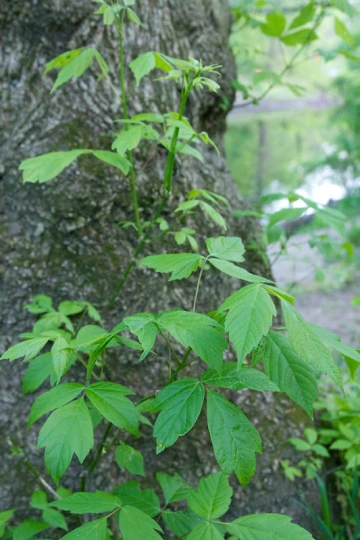
NatureServe Flickr.com
Botanical Family: Sapindaceae
Scientific Name: Acer negundo var. arizonicum
Common Names: Arizona boxelder maple, Arizona boxelder, box elder
Botanical Description:
Acer negundo var. arizonicum is a fast growing, deciduous tree with a spreading, bushy crown, typically reaching 4-12 meters in height, sometimes up to 20 meters, rarely a small shrub (1,2,3). The young bark is light brown in color, becoming grayish-brown and deeply grooved with age (3). Young branches are glabrous to somewhat glaucous with a smooth epidermis that is either reddish or greenish in color (2). The branches take on a gray color and somewhat rough texture with age (2). Division of Acer negundo into varieties or subspecies is primarily based on differences in indumentum (the covering of hairs) of the stems and leaves, with Acer negundo var. arizonicum having stems described as glabrous and glaucous, as compared to the dense, velvety spreading hairs on the leaves and stems of var. californicum, and the canescent, short-haired branches of var. interius (2,4). The leaves of Acer negundo var. arizonicum are pinnately compound, trifoliate, sometimes having more leaflets (up to 7), with leaflets being 2-4 inches long, irregularly lobed, smooth, green in color on the upper surface and pale on the lower surface (1,3). This species is wind-pollinated (but sometimes visited by bees) and dioecious, with male and female flowers occurring on separate trees from March to May (1,2,3). The staminate flowers occur in small, bundled, umbel-like fascicles, while the pistillate flowers, lacking petals, are racemose, 5 mm long, greenish yellow in color and occur in clusters on drooping stalks (1,3). After pollination, the pistillate flowers develop into 2.3-2.6 cm long samaras (winged achenes) that occur in pairs on drooping clusters and ripen between August and October, remaining on the tree through the winter (1,3).
Ecological Significance:
Acer negundo var. arizonicum, one of six recognized varieties of Acer negundo, is common in riparian areas, and other wet, wooded areas, in Arizona and New Mexico, from 3,000 ft to 9,100 ft (1,2,3). The boxelder is also adaptable to disturbed urban areas, where it thrives due to its fast growth, prolific seed production, and tolerance of low oxygen soils (2). It is both drought and flood tolerant (up to 30 days), typically growing best in moist soils (1,2,3). In wet lowlands, it adapts a shallow, spreading root system that allows it to survive in unstable and flooded soils lacking in oxygen (2,3). Forms of Acer negundo inhabit overlapping geographic areas and populations intermix with one another, complicating taxonomy (4). Because the seeds persist on the tree throughout the winter (when food is scarce), they are an important source of food for birds and mammals (3). Seedlings and young saplings are sometimes mistaken for poison ivy (Toxicodendron radicans), due to a striking resemblance (2,3). The two can be distinguished by noting the leaf arrangement, with A. negundo leaves arranged opposite and those of T. radicans appearing alternate (1,3).
Ethnobotanical Value:
The sap of Acer negundo has a high sugar content and is used to make a syrup that is sometimes referred to as mountain molasses (2,5). The plant is also used to make interior finishings, crates, boxes, pulp for paper, and some low-grade furniture (2,3,5). Native Americans have used the cambium for food and boiled down the sap for syrup and candy (2,5). A tea made from the inner bark was used to induce vomiting (an emetic), and the young branches were used to create charcoal for ceremonial paintings (2,5).
Distribution:
Arizona, New Mexico

